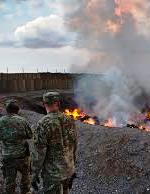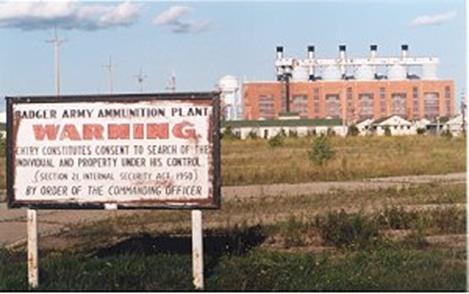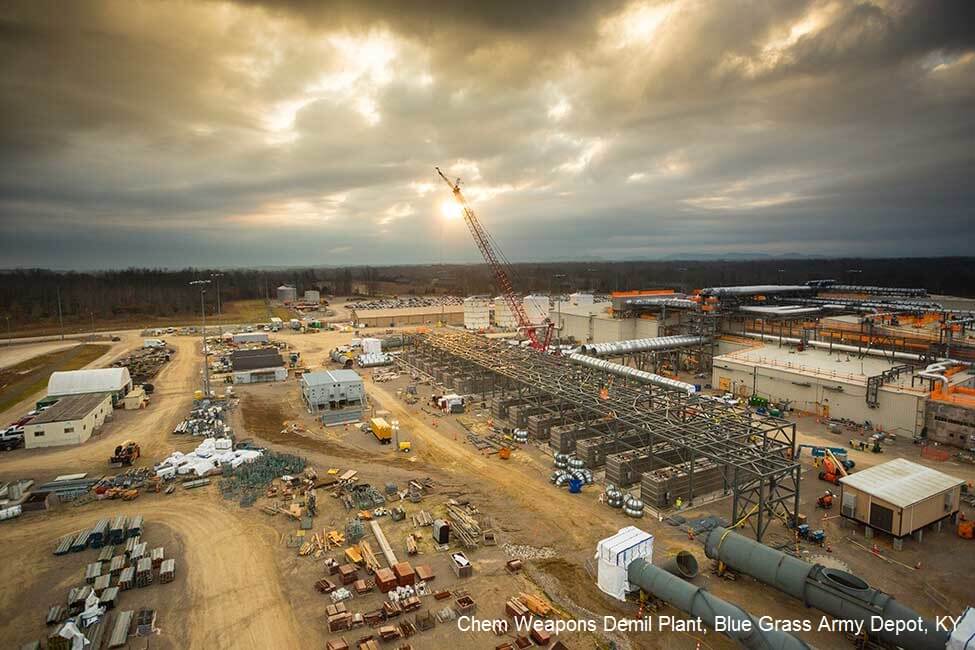 By Daniel Ross /AlterNet
By Daniel Ross /AlterNet
By the year 2020, the U.S. is expected to have on its hands a growing stockpile of munitions nearing 1.1 million tons that are no longer considered useful to the military. As a means of disposal, these munitions, including small arms cartridges, rockets, mortars, artillery shells, tactical missiles and other wastes, have for decades been burned or detonated on large trays out in the open at military bases across the country.
Canada and a number of European countries like Germany and the Netherlands have banned the practice, for good reason. Plumes of toxic smoke from burn pits have been documented drifting over surrounding communities, while the destroyed munitions expel pollutants that leach into the soil and groundwater. These pollutants include an array of highly toxic chemicals such as dioxins and furans, PCBs, chromium, dinitrotoluene (DNT), and perchlorate. Many of these toxic chemicals are known carcinogens, while all of them can cause chronic illnesses in humans and wildlife.
While the open burning of hazardous waste was prohibited at the federal level back in the 1970s, the military was given an exemption to open-burn munitions under the proviso that no alternative disposal methods were available.
The latest version of the National Defense Authorization Act includes an amendment directing the National Academy of Sciences to study safer, environmentally cleaner methods of disposing of munitions. Only, many of the alternatives methods likely to be studied have been around for years, which leaves critics of the practice wondering why it has taken so long to reach this critical juncture.
“The capacity is there for us to do it, you just have to have the political will and the desire within the defense department to do it” said Craig Williams, program director of the Kentucky Environmental Foundation and a longtime critic of open burning, calling it “a very primitive and dangerous practice.”
 The environmental toll from open burning is evident at a number of different military bases. At the now-decommissioned Badger Army Munitions Plant in Wisconsin, a federal Superfund cleanup site, two groundwater plumes containing DNT and chlorinated solvents extend for miles away from former open burn sites before leaching into the nearby Wisconsin River, a protected waterway. In the 1990s, the state health department found that people supplied water from contaminated drinking water wells surrounding the plant had a “slight increased risk of developing cancer.”
The environmental toll from open burning is evident at a number of different military bases. At the now-decommissioned Badger Army Munitions Plant in Wisconsin, a federal Superfund cleanup site, two groundwater plumes containing DNT and chlorinated solvents extend for miles away from former open burn sites before leaching into the nearby Wisconsin River, a protected waterway. In the 1990s, the state health department found that people supplied water from contaminated drinking water wells surrounding the plant had a “slight increased risk of developing cancer.”
Too often though, the full reach of contamination is hard to accurately gauge around open burn sites because of inadequate air, soil and groundwater monitoring.
At the Radford Army Ammunitions Plant in Virginia, the same toxic chemicals found in groundwater and soil beneath its open burn site have been detected in multiple drinking water and irrigation systems within a 10-mile radius from the plant. But no comprehensive monitoring or testing has been conducted beyond the perimeter of Radford to prove that the chemicals originate from the plant. Instead, officials say, these chemicals could have originated from other sources, like fertilizers.
A dearth of hard data makes the human health impact of open burning even harder to quantify, but that’s not to say links haven’t been made. A study from 1991 suggests a relationship between open burning and higher instances of breast, lung and pancreatic cancer. Last year, the Department of Veteran’s Affairs published a report finding that soldiers who had worked at open burn pits in Afghanistan and Iraq suffered higher instances of respiratory diseases like chronic obstructive pulmonary disease, emphysema and chronic bronchitis.
As far back as 1991, the Environmental Protection Agency informed the military that alternatives to open burning and detonation “can and should be developed.” Less than 10 years later, the EPA was already looking to see how disposal methods for chemical weapons as part of the Assembled Chemical Weapons Assessment program—implemented to identify safe disposal methods for chemical weapons here in the U.S.—could be used to destroy other waste hazards, including conventional munitions.
Some of these alternative methods include Supercritical Water Oxidization (a disposal process using water, high temperature and high pressure), detonation chambers, and Gas Phase Reduction, by which hazardous wastes are put through a highly expedited process of natural decay, leaving behind recyclable metal waste and hydrogen—and methane gas that can be used as an energy source.
“Gas Phase Reduction has been used on a commercial scale since the 1990s,” said Doug Hallett, the inventor of the technology. “We don’t leave the same harmful byproducts as with incineration or anaerobic digestion. It’s a rugged technology. It’s never had an environmental excursion or accident—ever.”
Next month, plant operators at the U.S. Army Pueblo Chemical Depot in Colorado will begin destroying 2,611 tons of mustard agent in projectiles and mortars through a process of hydrolysis (the chemical breakdown in water) followed by biodegradation. A combination of hydrolysis and Supercritical Water Oxidization will be used to destroy 523 tons of mustard agents and nerve agents in rockets and projectiles at the Blue Grass Army Depot in Kentucky, starting in 2020.
The cost of both programs, from initial design through decommissioning, program management costs and closure, is estimated to reach $10.6 billion.
 “The methods deployed at Blue Grass now are…the best of our technological capabilities,” said Williams, who added that in general, the difficulties and potential risks involved with destroying chemical weapons are greater than for conventional weapons. “The thing with open burning is that it’s cheap, it’s easy, and the regulators let them get away with it.”
“The methods deployed at Blue Grass now are…the best of our technological capabilities,” said Williams, who added that in general, the difficulties and potential risks involved with destroying chemical weapons are greater than for conventional weapons. “The thing with open burning is that it’s cheap, it’s easy, and the regulators let them get away with it.”
Some facilities have already taken steps to do away with open burning, replacing the practice with on-site incinerators. The contained burn unit at the Camp Minden military facility in Louisiana is the most technologically advanced in the world, say experts. And plans are underway to install an incinerator at Radford, say army officials at the plant.
Still, while incinerators are an environmental step up from open burning, they’re not a magic bullet when it comes to destroying the nation’s massive stockpile of munitions, said Laura Olah, co-founder of the Cease Fire Campaign, an organization that has long been at the vanguard of the push at the federal level to end open burning.
That’s because incinerators are still a toxic technology, she said, adding that “even the most technologically advanced incinerators release hundreds of hazardous byproducts including dioxins, heavy metals, and organic compounds in the form of toxic air emissions, particulates and ash.”
Approval of a final version of the National Defense Authorization Act is expected to come in late September, before the end of the fiscal year. If approved, the proposed National Academy of Sciences 18-month study can’t come soon enough for some.
“Obviously, if there were to be an instant moratorium on open burning we’d prefer to have that because it would offer immediate relief,” said Mark Toohey, a juvenile judge who lives within a mile-and-a-half of the Holston Army Ammunitions Plant in Tennessee, where open burning is conducted. “But we’re still satisfied with the current approach.”
Last year in a damning report, Tennessee’s Division of Solid Waste Management Toxic Substance Program blasted the plant for open burning bulk PCB waste. Toohey has described “thick plumes” like “tornadoes” emanating from the open burn site at Holston, moving quickly across the ground, enveloping nearby homes.
“It’s really changed the way we [as a family] view what chemicals are put out into the environment,” said Toohey, about his campaign to end open burning at Holston. “As well as about who’s putting those chemicals into the environment, and about who’s regulating it—or not.”
Daniel Ross is an LA-based journalist who regularly contributes to Truthout, The Guardian, Vice Magazine and The Huffington Post, among others.

